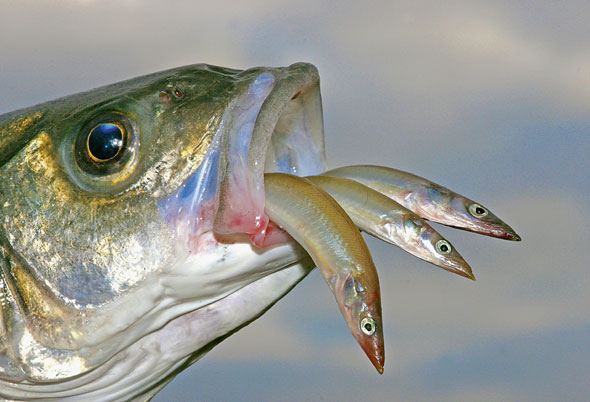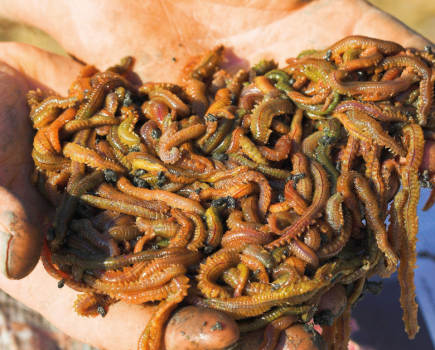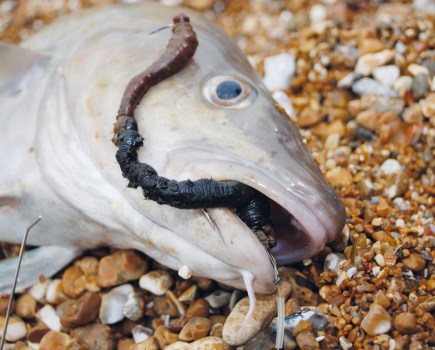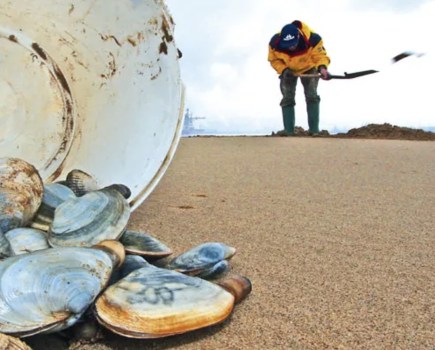Being one of the most abundant species in the seas, sandeels are a very important food for many species of fish, birds and other marine animals, and more or less hold the marine food chain together.
Just about everything that swims in the sea will feed on these silver fish at some time during its life, and some species are entirely dependent upon them. They have been fished for commercially for many years in the North Sea and are pulped and then used for fertiliser or fish food for salmon farms, among other uses.
This year sandeel numbers in the North Sea are estimated at only 150 billion fish, which is way below critical levels to sustain any fishery.
The North Sea sandeel fishery was expected to be closed indefinitely within weeks of writing this (September 2007) and the Danish fishery has already ceased. This is good news for the many species of birds that feed on sandeels, some of which have been in severe decline due to a shortage of the eels. Obviously any fish species that feeds on sandeels will now have a better chance of survival.
There are several species present around the British Isles, including Raitt’s sandeel (lesser sandeel), Corbin’s sandeel, and the greater sandeel (launce) that features on the British rod-caught mini-species record list at just over 8oz.
Collecting, buying and storage
Live specimens are usually difficult to obtain, and are usually caught by accident on small lures, although there are areas where very small lures can take them in numbers. They are keenly collected for bait and either used immediately or frozen for later use. The bigger specimens, or launce, are often hooked on mackerel gear.
Sandeels can be collected by digging on a sandy beach. In areas where they exist in numbers, a special tool known as a vingler can be used to collect them. This is a long-handled rod with a curve at the end, which is drawn through the sand. Individual eels are then caught in the inner bend and extracted.
They can be kept alive for a few hours in a bucket of seawater, and a bit longer in cool, aerated water, but it is difficult to keep them alive for more than a day or so. A wooden container with holes in it – known as a courge – can be used to keep them alive while you are fishing. Alternatively, you can use a wicker basket that allows oxygenated water to pass through, but stops the sandeels from getting out. The container is then hung over the side of the boat or pier.
The good news is that there are some companies that catch and blast freeze sandeels for use as bait, and most anglers will be very familiar with vacuum-packed frozen sandeels. The even better news is that frozen sandeels often outfish fresh ones. The frozen eels should be kept in a small cool box with freezer blocks and used selectively as the fishing session progresses, or they can be removed from their wrapper and stored in a vacuum flask. Once defrosted they are surprisingly tough, but will eventually become soft if not used within a few hours. Treat them well and they won’t let you down.
Where to fish
Sandeels like highly-oxygenated water and will be present in large numbers along the surf line, in strong tidal flows, and around sandbanks, where water movement adds oxygen to the water.
Predatory fish that favour this type of ground, particularly turbot and bass, will take a sandeel bait, and the thrill of catching one on a live sandeel is a great experience.
Similarly, a rocky outcrop or reef that has a good tidal movement will have its resident bass, pollack or coalfish eagerly awaiting a passing sandeel.
Using sandeels
The effectiveness of sandeels as a bait has long been realised, but their use depends on the size and species you expect to catch.
SMALL SANDEELS: The smaller ones, say up to 5-6in long, can be used singularly or in pairs to make a slightly bigger bait. The tail of the top eel overlaps the head of the lower eel, and both are secured with elastic cotton to give the effect of a much bigger bait.
LARGE SANDEELS: The bigger ones can be used either whole for bigger fish such as bass or rays, cut into two or three sections, or filleted into strips by running a sharp knife down the flanks. The full-length strips are cut into a bait to either freeline or troll for bass or pollack, floatfish for various species, or cut into smaller strips to tip off a worm bait to pick out the bigger whiting, pouting or flounders. Winter flounders seem to like a worm bait tipped off with a sandeel, rather than mackerel.
SECTIONS: A small, thick body section from a bigger eel makes a cocktail bait for bass, rays, congers and various dogfish. A body section around 6in long, either whole or with the backbone removed, is threaded up a wide-gape hook exactly as if you were baiting with a big worm. It is secured with elastic cotton and finished with either squid, ragworms or a chunk of mackerel.
FLOATFISHING: Smaller eels can be used for floatfishing; a strong hook such as a size 2/0 Mustad Viking will handle a bigger pollack or bass. The eel is hooked once through the upper lip or eye socket. Fish as light as possible to give the eel a more natural movement.
FREELINING/TROLLING: Use when fishing from the shore or boat. The smaller eels can be hooked through the top lip with a single hook. Bigger ones can either be lightly lip-hooked, or held on a Pennell rig for more security and to give a greater chance of hooking a bigger fish. To do this, pass a hook through the top of the middle body and then push a Pennell hook through the upper lip. The trace line can be passed through the gill opening and out of the mouth first before the Pennell hook is used. Securing with elastic cotton makes casting them out a lot easier.
FLAPPER: Bigger eels can be used as a flapper on a long trace when boat fishing. The backbone is exposed and removed by running a sharp knife along each side. This bait has a lot more movement to it, as well as giving off a scent trail. As with shore fishing, use just enough lead to get to the bottom and overcome tidal movement. That way the bait will look more appealing.

Sandeels are very fast swimmers, so when you are trolling or freelining you need to retrieve quickly. A fast-retrieved bait – often retrieved a lot faster than you think would be necessary – will often outfish a much slower bait.







